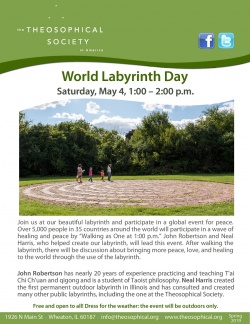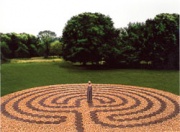Labyrinth: Difference between revisions
No edit summary |
No edit summary |
||
| Line 3: | Line 3: | ||
Scholars today distinguish between a maze (a multicursal puzzle with choices of path and direction) and a labyrinth (a single, non-branching path, which leads to the center). | Scholars today distinguish between a maze (a multicursal puzzle with choices of path and direction) and a labyrinth (a single, non-branching path, which leads to the center). | ||
== Labyrinth walking as spiritual practice == | |||
== Types of labyrinths == | == Types of labyrinths == | ||
Construction of walking labyrinths is typically of stone and gravel, or garden plantings. Finger labyrinths can be created using paper, ceramics, fabrics, or other materials. There are several common designs for labyrinths, with many variations. These are the Cretan style (left), Chartres style (center), and spiral (right): | |||
{|style="margin: 0 auto;" | {|style="margin: 0 auto;" | ||
| [[File:Chartres Labyrinth.jpg|200px| | | [[File:Cretan Labyrinth.jpg|200px]] [[File:Chartres Labyrinth.jpg|200px]] [[File:Spiral Finger Labyrinth.jpg|200px]] | ||
|} | |} | ||
[[File:Labyrinth at Olcott.jpg|180px|right|thumb|Labyrinth at Olcott campus]] | [[File:Labyrinth at Olcott.jpg|180px|right|thumb|Labyrinth at Olcott campus]] | ||
| Line 29: | Line 32: | ||
== Online resources == | == Online resources == | ||
=== Websites === | === Websites === | ||
* [https://labyrinthsociety.org/home The Labyrinth Society] | |||
* [https://labyrinthlocator.com/ Worldwide Labyrinth Locator] | * [https://labyrinthlocator.com/ Worldwide Labyrinth Locator] | ||
| Line 34: | Line 38: | ||
* [http://www.theosophical.org/publications/quest-magazine/1276# The Labyrinth: A Brief Introduction to its History, Meaning and Use] by John Algeo | * [http://www.theosophical.org/publications/quest-magazine/1276# The Labyrinth: A Brief Introduction to its History, Meaning and Use] by John Algeo | ||
* [http://www.theosophical.org/publications/quest-magazine/1547# Going Around in Circles: The Labyrinths of Theosophy] by Atala Dorothy Toy | * [http://www.theosophical.org/publications/quest-magazine/1547# Going Around in Circles: The Labyrinths of Theosophy] by Atala Dorothy Toy | ||
* [https://educationsvoice.wordpress.com/2016/03/26/mindfulness-in-the-classroom-finger-labyrinth-meditation/ Mindfulness in the Classrom - Finger Labyrinth Meditation]. Blog entry posted March 26, 2016. | |||
===Videos=== | ===Videos=== | ||
Revision as of 18:58, 10 May 2019
A Labyrinth (from the Greek λαβύρινθος labyrinthos) was in Greek mythology an elaborate structure designed to hold the Minotaur, a mythical creature that was half man and half bull. The Minotaur was killed by the Athenian hero Theseus who was able to escape with the aid of Ariadne, who provided him with a skein of thread.
Scholars today distinguish between a maze (a multicursal puzzle with choices of path and direction) and a labyrinth (a single, non-branching path, which leads to the center).
Labyrinth walking as spiritual practice
Types of labyrinths
Construction of walking labyrinths is typically of stone and gravel, or garden plantings. Finger labyrinths can be created using paper, ceramics, fabrics, or other materials. There are several common designs for labyrinths, with many variations. These are the Cretan style (left), Chartres style (center), and spiral (right):
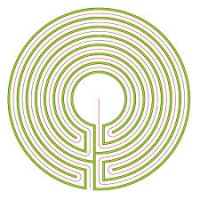 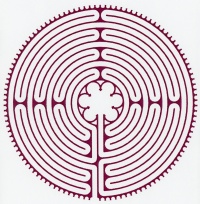 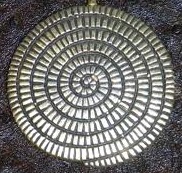
|
Labyrinth at Olcott
Several Theosophical centers have built labyrinths to encourage this meditative practice.
Behind the L. W. Rogers Building, on the west side of the headquarters campus of the Theosophical Society in America, is a classical seven-circuit Cretan labyrinth. Composed of large stepping stones on a field of pebbles, the labyrinth symbolizes the seven aspects of the cosmos and the human being. Walking its winding path from the circumference to the center and back out again represents the involution and evolution of the universe, the birth and passing from life of an individual, and a quest to the center of our being and subsequent return to our divine source. Many visitors come to Olcott to walk the labyrinth throughout the daylight hours, when the grounds are open.
Labyrinth at Krotona
Krotona Institute of Theosophy in Ojai, California has a simple hill-top labyrinth of stones in a grassy field.
Online resources
Websites
Articles
- The Labyrinth: A Brief Introduction to its History, Meaning and Use by John Algeo
- Going Around in Circles: The Labyrinths of Theosophy by Atala Dorothy Toy
- Mindfulness in the Classrom - Finger Labyrinth Meditation. Blog entry posted March 26, 2016.
Videos
- Betty Bland on Labyrinths, Theosophy, & Prayer interview by Susan Diamond and Erika Harris.
